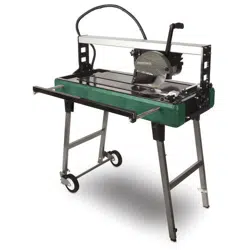Loading ...
Loading ...
Loading ...

– 2 –
19. DO NOT DRY CUT WITH BLADES
DESIGNED FOR WET CUTS.
20. Make sure you USE THE CORRECT BLADE
for the job you are doing.
21. NEVER STAND ON TOOL. Serious injury
could occur if the wet saw is tipped or if the
cutting tool is unintentionally contacted.
22. CHECK DAMAGED PARTS. Before further
use of the tool, damaged part(s), (i.e.,
guard) should be carefully checked to
determine that it will operate properly
and perform its intended function. Check
for alignment of moving parts, binding of
moving parts, breakage of parts, mounting
and any other condition that may affect the
saw’s operation. A guard or other part that
is damaged should be properly repaired
or replaced.
23. ENSURE THAT BLADE IS TRAVELING
THROUGH WATER RESERVOIR FOR WET
CUTTING.
24. CHECK DIAMOND BLADES carefully for
cracks, nicks, missing diamond matrix
or out-of-alignment condition. Replace
damaged blades immediately. DO NOT
USE DAMAGED BLADES. They may cause
bodily injury.
25. DIRECTION OF FEED. Feed work into the
blade against the direction of rotation of
the blade only.
26. DO NOT ALTER THE PLUG or use a 2-prong
receptacle. This saw is equipped with a
3-prong electrical plug.
27. NEVER LEAVE SAW RUNNING
UNATTENDED. Turn power off. Don’t leave
tool until it comes to a complete stop.
28. POSITIONING OF TILE SAW (see FIGURE 1)
• To avoid the possibility of the appliance plug
or receptacle getting wet, position the tile
saw to one side of a wall-mounted receptacle
to prevent water from dripping onto the
receptacle or plug. The user should arrange
a “drip loop” in the cord connecting the saw
to a receptacle. The “drip loop” is that part
of the cord below the level of the receptacle,
or connector if an extension cord is used, to
prevent water traveling along the cord and
coming in contact with the receptacle.
• If the plug or receptacle does get wet, DO
NOT unplug the cord. Disconnect the fuse
or circuit breaker that supplies power to the
tool. Then, unplug and examine for presence
of water in the receptacle.
SPECIFIC OPERATION GUIDE
1. Ensure that the directional arrow marked
on the blade corresponds with the
rotational direction of the motor.
2. With the saw disconnected from the power
supply, rotate the blade by hand to ensure it
is free from obstruction.
3. Always keep the blade-securing arbor and
collars clean.
4. Ensure that the blade-securing bolt is
securely tightened.
5. Never try to cut freehand. Always ensure
that the tile to be cut is pressed firmly
against the rip fence.
6. Ensure that the workpiece that will be cut
off has sufficient room to move sideways.
Failure to do so may result in the off-cut
binding against the blade.
7. Never cut more than one tile at a time.
8. Never cut pieces too small that are not held
securely against the rip fence, and provide
enough space for the hand to be a safe
distance from the blade.
9. Ensure that the table and surrounding area
are clear with the exception of the tile to
be cut.
10. Before cutting a tile piece, let the saw
blade run freely for a few seconds. If it
makes an unfamiliar sound or vibrates
excessively, switch it off immediately and
disconnect it from the power supply.
11. Let the blade reach full speed before
commencing the cut.
12. Let the blade come to a complete stop
before removing any jammed material from
around the blade area.
DRIP LOOP
TOOL
POWER
SUPPLY CORD
FIGURE 1
Loading ...
Loading ...
Loading ...
